Genre: Beat-‘Em-Up Developer: Kaneko Publisher: Kaneko Players: 1 Released: 1990
Tradewest’s Double Dragon spawned a deluge of beat-’em-up clones that tried to capitalize on its success. Those who remember arcades and game consoles before the coming of Street Fighter II can probably name a dozen or so titles that fit the mold, and that generally seems to be the way the game industry works. A fresh and invigorating game comes along and draws years’ worth of imitators until it is finally overthrown by the next fresh and invigorating game. Most people tend to overlook the majority of these releases, but discerning gamers separate the wheat from the chaff, looking for that underrated gem that actually improved upon the very title from which it draws inspiration.
Before I continue, let me just make it clear that DJ Boy is not that title. I was just getting a bit philosophical there, so forgive me if I mislead you. No, DJ Boy is pretty derivative, and its only true claims to fame are probably the fact that everyone involved is wearing roller skates – which in no way impacts the gameplay – and that it features some of the most controversial boss characters on the Genesis. That is, if you’re playing the superior and quite different Japanese version.
Anyone familiar with Kaneko’s arcade brawler is aware that the Mega Drive port featured some pretty odd changes. “Big Mama,” the first boss, for example, had her farting animation turned into a full-blown (pardon the pun) attack, and she was actually made more stereotypical in presentation. The story was altered from one about DJ Boy out to retrieve his stolen boom box to instead having him assume the tired role of girlfriend savior. Perhaps the most annoying omission is the two-player cooperative mode. Nothing says “boring” like a single-player beat-’em-up. Memory limitations, perhaps? Probably a cost-cutting measure or just lazy development.
With those changes in mind, either the American version (which is more toned-down in presentation) or its Japanese counterpart are essentially the same in gameplay. Several stages have undergone changes, such as the first part of the first level and the layout of level two, but you’re still running around on roller skates punching and kicking your foes. No combos, no special attacks…nope, you’re armed with only the ability to kick and punch forward and backwards. Button mashing is the rule of the day, and there’s absolutely no technique involved. Enemies are your standard arcade thugs who are more clueless than a banjo-playing cousin, and each level basically boils down to the player just running around, kicking baddies as he passes them by. Punches aren’t too useful due to their limited range, and it’s not like you’ll really need them. Henchmen like this are why bad guys never win.
Bosses are a bit different. With a life bar that’s more than two times the size of DJ Boy’s, some of them require a particular style of attack. Big Mama will always win a beat down face off, and the second boss is virtually immune to punches. You can’t just flail away at them, unless you’re eager for a “game over” screen. They all do massive damage, and your single life will drain away quite quickly if you just try to duke it out with them.
After you’ve passed a level, you’re taken to a store where you can spend the coins that each defeated enemy releases. Increase your speed, power, endurance, or just fill up your empty life bar – the choice is yours. If you steadily increase your power, you can kill most basic enemies with a single hit by level four. How’s that for challenge! The cute kitty icon is for an extra life, something vital for beating DJ Boy. Few people will make it to the end with the single life you’re given from the get-go.
That kitty’s about the only eye-catching thing in this game. The visuals are pretty bland, with a minimum use of parallax scrolling. Animations are few and far between, and the colors are pretty much what you’d expect from a first-generation Genesis title. The audio is on par with the graphics, and the presentation overall does little to motivate the player. This is more or less the story for most games of this era, so don’t take it personally DJ Boy!
Sitting in the middle of this lake of mediocrity is some cool level design. Level two’s dark run through an obstacle-ridden subway is fun, and level four’s high rise construction site is a challenge due to the quick death that’s just a poorly-timed jump away. I liked the dynamite-tossing girl in the trolley from the first level, and she really should have been used more. Since the level’s don’t drag on, you’re really never in any danger of dying off before a boss. Just save your cash for punch and endurance, and be sure to buy a kitty here and there, and you should be fine.
If you’re eager to see what an early Genesis beat-’em-up was like, or you’re just looking for another cheap title to pad your collection, DJ Boy is probably worth the few bucks it should cost you. OF course, anyone looking for the next Streets of Rage 2 is going to be HIGHLY disappointed (and the butt of more than a few jokes, I’d wager). I’d go with the Japanese version if given the choice, but it might actually be worth owning both, given how many changes were made between them. At the end of the day, the fun factor is about the same.
SCORE: 5 out of 10

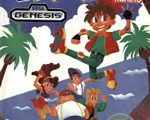
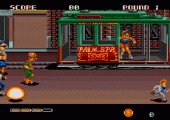
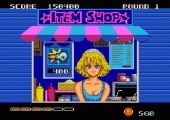
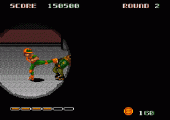
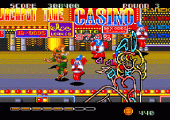
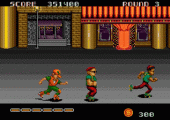
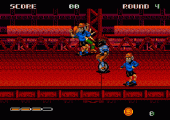
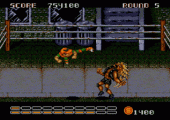
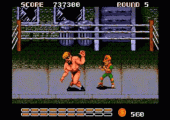
Recent Comments